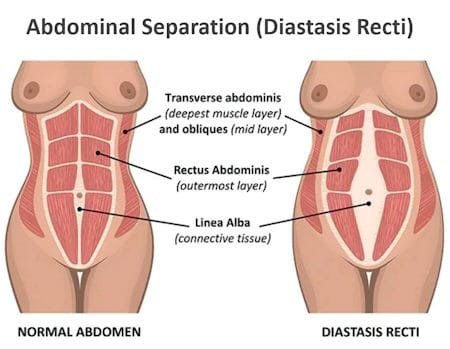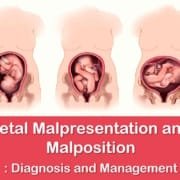Abdominal Separation (Diastasis Recti): Symptoms, Treatment & Prevention
Abdominal separation, also known as diastasis recti, is a condition commonly experienced during and after pregnancy. It occurs when the two parallel bands of the rectus abdominis muscles, more commonly known as the “six-pack” muscles, separate along the midline of the abdomen. While this is a natural adaptation during pregnancy to make room for the growing baby, many women continue to experience the effects of diastasis recti long after giving birth.
What is Abdominal Separation (Diastasis Recti)?
Abdominal separation occurs when the connective tissue between the rectus abdominis muscles stretches or tears. This separation often develops during the later stages of pregnancy, as the uterus expands and applies pressure on the abdominal wall. It is a common condition, with up to 60% of women experiencing it after delivery. In some cases, it may persist for months or even years without proper intervention.

Understanding Abdominal Muscles
The abdominal muscles consist of several layers:
- External oblique muscles – located on the sides of the abdomen
- Internal oblique muscles – deeper muscles under the external obliques
- Rectus abdominis muscles – the “six-pack” muscles running from the chest to the pelvis
- Transversus abdominis muscles – the deepest layer, supporting the core and spine
Together, these muscles provide core stability, support the spine, and play a critical role in posture, movement, and breathing.
What Causes Abdominal Separation?
Several factors contribute to the development of diastasis recti, including:
- Pregnancy: The growing baby exerts pressure on the abdominal wall, causing the muscles to stretch and separate.
- Hormonal Changes: Pregnancy hormones, such as relaxin, soften the connective tissue, making it easier for the muscles to separate.
- Straining during Labor: Pushing during delivery can further strain the abdominal muscles.
- Age and Multiple Pregnancies: Women over 35 or those who have had multiple pregnancies are at a higher risk of experiencing diastasis recti.
- Other Factors: Excessive weight gain, constipation, and chronic coughing can increase abdominal pressure, contributing to muscle separation.
Signs and Symptoms of Abdominal Separation
Diastasis recti is not typically associated with pain, but it can cause noticeable changes in the appearance and function of the abdomen:
- Visible Gap: A noticeable gap or bulge between the abdominal muscles, especially when performing core exercises or lifting.
- Weak Core: Women often report a feeling of weakness in their core, particularly when lifting heavy objects.
- Lower Back Pain: The weakened abdominal muscles may no longer provide adequate support for the lower back, leading to discomfort or pain.
- Pelvic Floor Issues: The separation of the abdominal muscles can also contribute to pelvic floor dysfunction, leading to urinary incontinence or other related symptoms.
How to Check for Abdominal Separation
If you suspect you have diastasis recti, you can perform a simple self-assessment:
- Lie on your back with your knees bent and feet flat on the floor.
- Place your fingertips just above your belly button.
- Lift your head and shoulders slightly off the floor, as if doing a crunch.
- If you feel a gap wider than one or two fingers between your abdominal muscles, you may have diastasis recti.
Can Diastasis Recti Go Away on Its Own?
For many women, the separation gradually decreases in the weeks and months following childbirth, especially with the help of gentle core-strengthening exercises. However, for some, diastasis recti may persist, requiring additional interventions to fully resolve.
Treatment Options for Diastasis Recti
There are several ways to treat diastasis recti, depending on the severity of the condition and how long it has been present:

1. Exercise Therapy
One of the most effective ways to manage diastasis recti is through specific exercises that focus on strengthening the deep abdominal muscles. It’s important to avoid traditional sit-ups or crunches, as these can exacerbate the separation.
Pelvic Tilts
This exercise helps strengthen the core without putting excessive strain on the abdominal muscles.
- Lie on your back with your knees bent and feet flat on the floor.
- Gently tilt your pelvis backward, flattening your lower back against the floor.
- Hold for 3 to 5 seconds, then relax.
- Repeat 5 to 10 times.
Abdominal Bracing
Another useful exercise for diastasis recti is abdominal bracing, which targets the deep core muscles.
- Lie on your back or sit upright.
- Gently draw your belly button in toward your spine.
- Hold the contraction for 5 to 10 seconds, then release.
- Repeat 5 to 10 times.
2. Wearing an Abdominal Separation Belt
Many women find relief by wearing an abdominal separation belt or diastasis recti splint. These belts provide external support to the abdominal muscles and help bring them closer together, reducing the strain on the connective tissue. Be sure to consult with a healthcare professional to ensure the belt is properly fitted and used in conjunction with exercise therapy.
3. Physical Therapy
For more severe cases of diastasis recti, a referral to a physical therapist specializing in women’s health may be recommended. A tailored exercise program that focuses on core strength, posture, and pelvic floor function can greatly improve symptoms.
4. Surgery
In rare cases where diastasis recti significantly impairs daily functioning and does not respond to exercise or physical therapy, surgery may be an option. Abdominoplasty, or “tummy tuck,” can repair the separated muscles and remove excess skin for a flatter, more toned appearance. However, surgery should only be considered after other treatment options have been explored.
Prevention of Abdominal Separation
While diastasis recti is a common condition during pregnancy, there are steps you can take to reduce your risk:
- Strengthen Core Muscles Before Pregnancy: Engaging in regular core exercises before becoming pregnant can help build a strong foundation, reducing the likelihood of severe muscle separation.
- Avoid Excessive Abdominal Strain: During pregnancy, avoid exercises and movements that place undue pressure on the abdominal muscles, such as heavy lifting, sit-ups, and intense core workouts.
- Maintain Good Posture: Proper posture throughout pregnancy can help distribute weight more evenly and minimize abdominal strain.
- Manage Coughing and Constipation: Chronic coughing and constipation can increase pressure on the abdomen. If you experience either, consult your healthcare provider for appropriate management strategies.
Frequently Asked Questions (FAQs)
What can I do to prevent diastasis recti during pregnancy?
To prevent diastasis recti during pregnancy, it’s important to strengthen your core muscles beforehand, avoid excessive straining or heavy lifting, practice good posture, and engage in safe prenatal exercises that don’t put too much pressure on your abdominal muscles.
Can back pain be a sign of diastasis recti?
Yes, back pain is a common symptom of diastasis recti. The weakened core muscles provide less support to the spine, which can lead to discomfort or pain in the lower back. Strengthening the core can help alleviate this issue.
1. Can you get diastasis recti from coughing?
No, coughing cannot give you diastasis recti. In fact, frequent or intense coughing can exacerbate diastasis recti by increasing abdominal pressure.
2. How can I fix diastasis recti years later?
It’s never too late to address diastasis recti. Exercise therapy, physical therapy, and even surgery are options for managing the condition, even years after pregnancy.
3. What are the benefits of wearing a belly splint for diastasis recti?
A belly splint provides external support to the abdominal muscles, helping them come closer together and reducing strain on the connective tissue. It is often used in conjunction with core-strengthening exercises.
What does diastasis recti look like before and after treatment?
Diastasis recti before treatment often appears as a bulge or gap in the midline of the abdomen, especially noticeable when doing activities that engage the core. After treatment, the gap narrows, and the abdominal muscles look flatter and more toned.
How can I fix diastasis recti years later without surgery?
It’s possible to fix diastasis recti even years after it develops by engaging in core-strengthening exercises specifically targeting the deep abdominal muscles, such as pelvic tilts, abdominal bracing, and transverse abdominis activation. Physical therapy can also be very effective.
Can wearing an abdominal separation belt help treat diastasis recti?
Yes, wearing an abdominal separation belt or diastasis recti splint can provide support to the abdominal muscles, helping them come closer together. This can aid in the healing process, especially when combined with exercise therapy.
Conclusion
Abdominal separation, or diastasis recti, is a common but manageable condition that many women experience during and after pregnancy. While it often resolves naturally, targeted exercises and lifestyle changes can accelerate healing and reduce symptoms such as back pain and core weakness. By understanding the causes, symptoms, and treatment options, women can take proactive steps to restore their abdominal health and prevent future complications.










